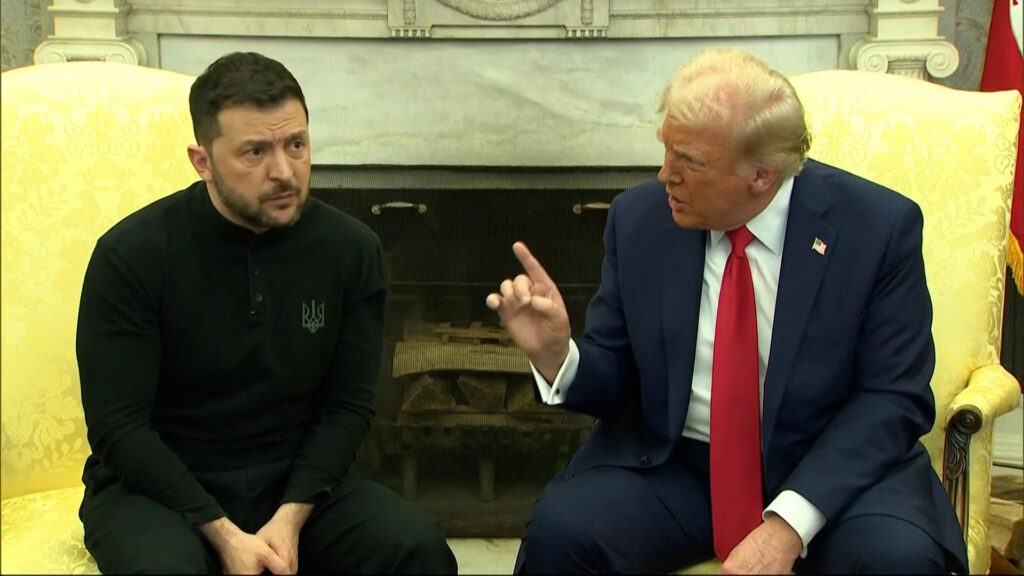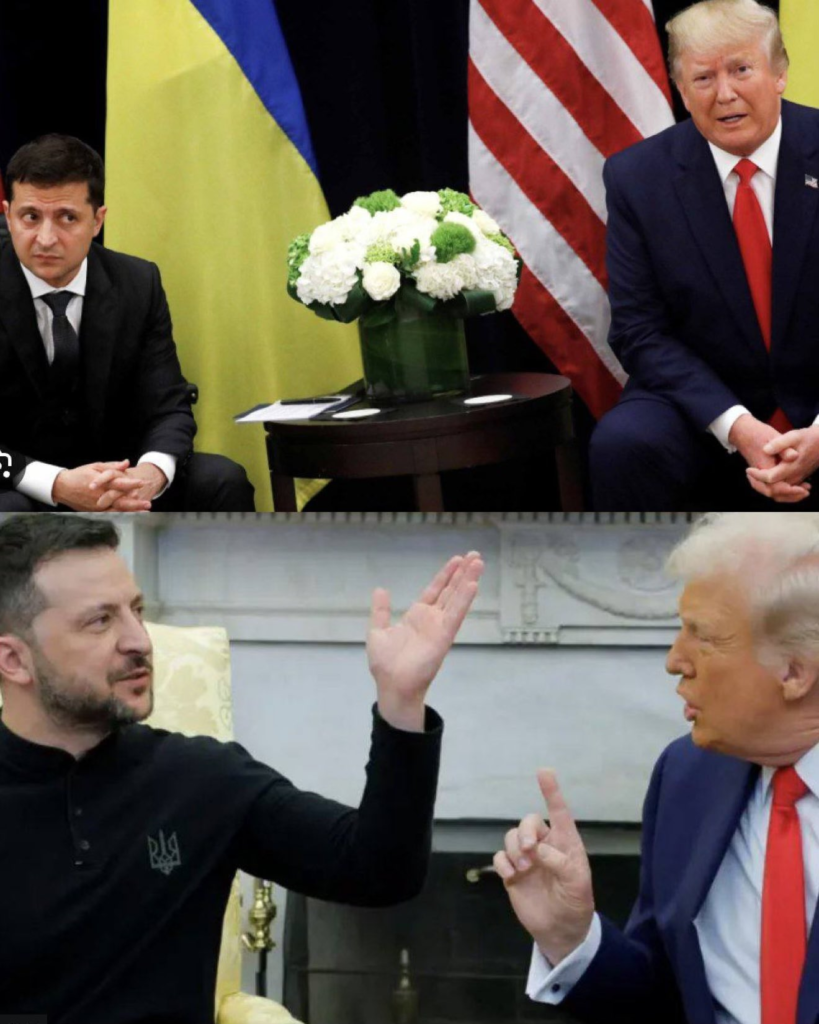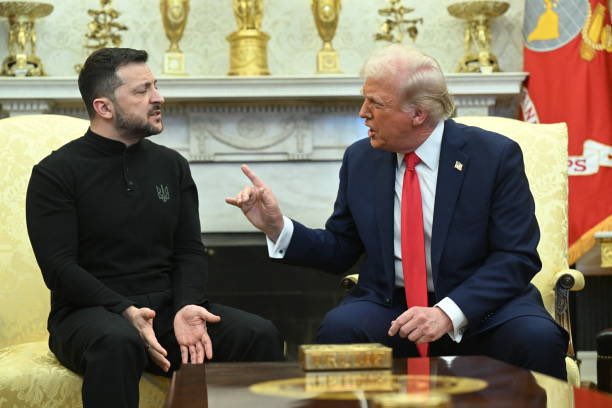US President Donald Trump’s meeting with Ukrainian President Volodymyr Zelensky at the White House on Friday (February 28) began cordially but soon erupted into a heated dispute, a catfight of sorts in front of the global media. Reports indicated that the Ukrainian delegation was asked to leave, with the formal lunch left untouched.
This was their first meeting since Trump returned to office in January. It started with handshakes and polite exchanges but turned tense when US Vice President JD Vance stressed the importance of diplomacy in resolving the Russia-Ukraine war, which began with Russia’s invasion in 2022.
So what exactly happened here? Let’s have a detailed look starting with the transcript of the argument.
Triggering the Confrontation
The confrontation was triggered by President Trump’s demand for an apology from President Zelensky, which the latter refused, asserting Ukraine’s sovereignty and the need for security guarantees before any peace talks. Trump’s dissatisfaction with Zelensky’s stance led to the abrupt end of their meeting and the cancellation of a proposed minerals deal.
This incident has strained U.S.-Ukraine relations and raised concerns among international observers about the future of support for Ukraine in its conflict with Russia.
Transcript: Who Said What?
“We tried the pathway of (former US President) Joe Biden, of thumping our chest and pretending that the president of the United States’ words mattered more than the president of the United States’ actions. What makes America a good country is America engaging in diplomacy. That’s what President Trump is doing,” he added.
To this, Zelensky said if he could ask Vance a question.
“Sure. Yeah,” Vance responded.
“Okay. So he (Vladimir Putin) occupied it, our parts, big parts of Ukraine, parts of east and Crimea. So, he occupied it in 2014. During a lot of years – I’m not speaking about just Biden, but those times was (Barack) Obama, then President Trump, then President Biden, now President Trump and God bless, now, President Trump will stop him. But during 2014, nobody stopped him. He just occupied and took. He killed people,” the Ukraine President said, referring to the annexation of Crimea.
“From 2014 till 2022, the situation was the same. People have been dying on the contact line. Nobody stopped him. You know that we had conversations with him, a lot of conversations…. And we signed a deal with him. (French President Emmanuel) Macron and (former German Chancellor Angela) Merkel signed a ceasefire. All of them told me that he will never go… But after that, he broke the ceasefire, he killed our people, and he didn’t exchange prisoners. We signed the exchange of prisoners. But he didn’t do it. What kind of diplomacy, JD, are you speaking about? What do you mean?” Zelensky said.
“I’m talking about the kind of diplomacy that’s going to end the destruction of your country,” the US Vice President responded.
Zelensky then said, “Yes, but if you…” but was interrupted by Vance.
“Mr President, with respect, I think it’s disrespectful for you to come to the Oval Office and try to litigate this in front of the American media. Right now, you guys are going around and forcing conscripts to the frontlines because you have manpower problems. You should be thanking the president,” Vance said.
As the ugly clash continued, Zelensky asked Vance if he had “ever been” to Ukraine to “see the problems” that they have.
“I’ve actually watched and seen the stories, and I know what happens is you bring people on a propaganda tour, Mr President,” Vance said.
“Do you disagree that you’ve had problems with bringing people in your military, and do you think that it’s respectful to come to the Oval Office of the United States of America and attack the administration that is trying to prevent the destruction of your country?” he added.
In response to this, Zelensky said that “everybody has problems” during the war, even the US.
“You have nice solutions and don’t feel (it) now, but you will feel it in the future,” he said, triggering Trump.
“You don’t know that. Don’t tell us what we’re going to feel. We’re trying to solve a problem. Don’t tell us what we’re going to feel,” Trump responded.
“I am not telling you, I am answering…,” Zelensky said.
Trump then raised his voice and said, “You’re in no position to dictate what we’re going to feel. We’re going to feel very good and very strong.”
“You right now are not in a very good position. You’ve allowed yourself to be in a very bad position,” Trump added as Zelensky tried to interrupt him.
“You’re gambling with the lives of millions of people, you’re gambling with World War III, and what you’re doing is very disrespectful to this country,” the 78-year-old US President said.
Vance then asked Zelensky if he had said “thank you even once”.
“A lot of times,” Zelensky answered.
“No, in this meeting, this entire meeting? Offer some words of appreciation for the United States of America and the president who’s trying to save your country,” Vance said.
“Yes, you think that if you will speak very loudly about the war…” Zelensky was again cut off by Trump.
“He’s not speaking loud. Your country is in big trouble. No, no, you’ve done a lot of talking. Your country is in big trouble,” Trump said.
“You’re not winning this. You have a damn good chance of coming out OK, because of us,” he added.
Trump also told Zelensky that if Ukraine didn’t have the US’s military equipment, the war would have been over in two weeks.
“In three days. I heard it from Putin: in three days,” Zelensky responded.
“It’s going to be a very hard thing to do business like this. You’re buried there. Your people are dying. You’re running low on soldiers. No, listen… And then you tell us, ‘I don’t want a ceasefire. I don’t want a ceasefire. I want to go and I want this. You’re not acting at all thankful. And that’s not a nice thing. I’ll be honest, that’s not a nice thing,” Trump said.
Agenda of the Meeting: Trump
Immediate Ceasefire and Peace Negotiations
President Trump is eager to expedite an end to the Russia-Ukraine war. He has proposed a 100-day plan aiming for a ceasefire by Easter 2025, involving direct talks with both Russian President Vladimir Putin and President Zelensky. This plan includes Ukraine accepting Russian sovereignty over annexed territories and refraining from NATO membership. The plan, obviously, not acceptable to Ukraine.
His proposed approach includes many controversial ideas. Reports suggest that Trump is open to recognizing Russian control over territories annexed since 2014, including Crimea and parts of Donetsk and Luhansk. Trump has also hinted at blocking Ukraine’s NATO membership as part of a peace deal, believing it would reduce Russia’s aggression.
Rather than sending military aid, Trump is considering lifting certain economic sanctions on Russia in exchange for Putin agreeing to a ceasefire. This approach has sparked controversy, as critics argue it legitimizes Russia’s territorial gains and weakens Ukraine’s sovereignty.

Reallocation of U.S. Resources
Trump has expressed concerns about the extensive U.S. military aid to Ukraine, emphasizing the need to focus on other geopolitical challenges, particularly those posed by China. He suggests that European nations should take a more substantial role in supporting Ukraine’s defence. He believes NATO allies, especially Germany and France, should provide more financial and military support.
Trump sees China as the bigger long-term threat and wants to shift military resources toward countering its influence in the Pacific and Taiwan. He also argues that billions of dollars spent on Ukraine should instead go toward domestic priorities like infrastructure and tax cuts. During his recent meeting with Zelensky, Trump reportedly hinted at cutting future U.S. aid, which led to tensions between the two leaders.
Economic Interests
The U.S. administration has shown interest in Ukraine’s rich mineral resources. Discussions about economic deals concerning these resources have been part of the broader negotiations, although recent tensions have cast doubt on these prospects. This kind of American push into the
Ukraine has rich deposits of lithium and rare earth minerals, essential for modern technology and defence. These materials are critical for electronics, electric vehicles, and military equipment, making them valuable to global markets.
American companies were exploring potential investment opportunities in Ukraine’s mining and agriculture sectors. Ukraine is a major grain exporter, and the U.S. agribusiness industry sees significant trade potential. Trump’s team had discussed partnerships that could benefit both nations economically. But growing tensions between Trump and Zelensky have put these discussions on hold. Without political stability, investment remains uncertain.
Bonhomie with Russia?
Trump has suggested a reset in U.S.-Russia relations, which many see as a shift toward a pro-Putin approach. He has indicated that some sanctions on Russia could be lifted if Putin agrees to peace talks. This has raised concerns among NATO allies about weakening Western resistance to Russian aggression.
Trump’s comments suggest he believes Ukraine should accept Russian territorial gains to end the war. He argues that continued conflict is not in America’s interest. Many European leaders fear this could undermine Ukraine’s sovereignty and embolden Russian expansionism. Trump’s foreign policy signals a shift from European security to a focus on China and domestic priorities.
This has worried U.S. allies in NATO, who fear that Trump’s policies could undermine Western unity in supporting Ukraine.
U.S. Responsibility Towards Ukraine
The United States has a big responsibility towards Ukraine, both historically and in the present. In the 1990s, after the Soviet Union collapsed, Ukraine inherited a large nuclear arsenal. Under US pressure, Ukraine agreed to surrender its nuclear weapons in exchange for security assurances from the US, the UK, and Russia under the 1994 Budapest Memorandum. The agreement promised that Ukraine’s sovereignty would be respected, yet Russia violated this by annexing Crimea in 2014 and launching a full-scale invasion in 2022.
Having urged Ukraine to disarm, the US bears moral and strategic responsibility to support its defence. Since 2022, the US has been Ukraine’s largest military and financial backer, providing weapons, intelligence, and economic aid. However, President Trump’s recent stance signals a shift, with potential reductions in support and demands for a peace deal that may favour Russia.
America’s role extends beyond military aid. It has led economic sanctions against Russia, pressured allies to increase support, and shaped global narratives around the war. If the US withdraws support now, Ukraine could face severe setbacks, and Russia may feel emboldened to push further into Europe, undermining NATO.
What’s Next for Ukraine?

Volodymyr Zelensky declined to apologise for his dispute with Donald Trump. He said that he did not believe Ukraine had done anything wrong. Speaking to Fox News after the heated exchange with the US President and his deputy, he acknowledged that he would have preferred the confrontation to have occurred away from reporters. Despite the tensions, Zelensky expressed confidence that relations between the US and Ukraine could still be restored. He emphasised that the partnership between the two nations extended beyond their respective leaders.
Zelensky has maintained that Ukraine will not accept territorial concessions. This conflicts with Trump’s push for a ceasefire that could legitimise Russian control over annexed regions. The fallout from this disagreement is expected to have long-term diplomatic and strategic consequences.
Diplomatic Engagements and Peace Negotiations
With uncertainty surrounding U.S. support, European leaders are stepping up efforts to shape the next phase of the conflict. French President Emmanuel Macron is set to meet with other European leaders in London to discuss potential responses to Trump’s peace plan and explore alternative diplomatic strategies. While European nations have provided significant aid to Ukraine, there is concern about whether they can sustain military and economic support without strong U.S. backing. Some European officials believe a separate European-led peace initiative might be necessary if Trump continues to push for an agreement that favours Russian interests.
Ukraine is also looking toward allies such as the United Kingdom, Poland, and the Baltic states. These nations have been strong supporters of Ukraine throughout the conflict. Poland has suggested increasing direct military assistance, while the UK has reaffirmed its commitment to supporting Ukraine’s defence industry. The level of coordination between European nations and Ukraine will be the deciding factor. It will determine whether a unified front can be maintained.
Economic Considerations and Resource Management
One of the major points of contention during Trump and Zelensky’s meeting was a proposed economic deal involving Ukraine’s vast natural resources. Under this agreement, Ukraine would allocate 50% of the proceeds from state-owned mineral resources to a U.S.-managed fund. This deal was to be made in exchange for continued American support. Many within Ukraine see this as an unfair trade-off, even a new form of colonialism to weaken Ukraine’s economic sovereignty. The deal has sparked domestic debate. Some Ukrainian lawmakers are opposing any arrangement that gives foreign entities control over strategic resources.
Ukraine is also grappling with war-related economic challenges, including a struggling infrastructure and declining industrial output. The government is seeking alternative ways to finance the war effort. There are efforts for increased trade with European partners and leveraging international financial aid. With a growing need for reconstruction efforts in war-torn regions, Kyiv is hoping to attract private investment, but investors remain cautious due to the ongoing conflict. The uncertainty surrounding future U.S. support has made economic planning even more difficult.
Military Strategy and Defence Posture
With signs that U.S. military assistance may be reduced or come with stricter conditions, Ukraine is reassessing its defence strategy. The Ukrainian military has already shifted its focus toward increasing domestic weapons production, including drones, ammunition, and armoured vehicles. While the country has relied heavily on Western-supplied equipment, there is now an urgency to develop a more self-sufficient defence industry.
European countries, particularly Germany and the UK, are discussing ways to boost their military aid commitments. Germany has pledged additional air defence systems. On the other hand, the UK has signaled an interest in expanding arms production partnerships with Ukraine. Ukraine is also exploring the possibility of acquiring more long-range missiles to counter Russian advances.
Military analysts believe Ukraine will prioritize fortifying defensive positions, targeting Russian supply lines, and intensifying strikes on key military infrastructure in occupied territories. The situation on the battlefield remains fluid, with Russian forces continuing to push in the eastern regions, while Ukraine carries out counteroffensive operations where possible.
Domestic Sentiment and National Resilience
Despite growing external pressures, Ukraine’s population remains resilient. Civilian morale remains high, with many Ukrainians determined to resist Russian advances regardless of shifting international support. Cultural events, including concerts attended by soldiers and civilians, continue to reinforce a sense of national unity. Public opinion remains strongly against making territorial concessions to Russia, and there is broad support for continuing the fight until Ukraine regains control over its occupied lands.
Local communities have played a key role in supporting the war effort, from volunteer groups providing aid to small businesses adapting their operations to wartime conditions. Diplomatic efforts, economic strategies, and military adaptations will shape Ukraine’s ability to sustain its resistance and push toward a resolution that aligns with its national interests.



